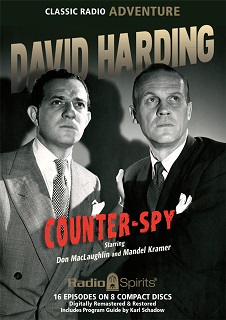
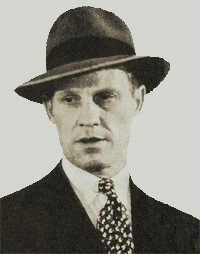 David Harding, Counter-Spy (1942-57) aired “The Case of the Desert Explosion” on May 12, 1949 as one of its estimated 850 broadcasts, of which only approximately 75 still exist.
David Harding, Counter-Spy (1942-57) aired “The Case of the Desert Explosion” on May 12, 1949 as one of its estimated 850 broadcasts, of which only approximately 75 still exist.
We showcased the first and only other episode of this fine program in March of this year. The creative genius behind Counter-Spy (retitled in 1946 to David Harding, Counter-Spy at the insistence of a new sponsor) was Phillips H. Lord (1902-1975, photo below left). Lord was highly respected in radio circles, having produced such popular programs as Gang Busters (1935-57), Mr. District Attorney (1939-53), and the patriotic series We, the People. When the United States entered world War II following the December 7, 1941 sneak attack on Pearl Harbor, Hawaii, Lord took notice that there were few true espionage programs on the air and decided to rectify the situation by creating Counter-Spy. Many of the stories were based on factual cases Lord had been given access to for use in his previous crime programs, but whose stories were of course dramatized, fictionalized accounts that proved popular with an anxious audience starved and ready for such Good Guys vs. Bad Guys espionage stories with the war at the forefront of their minds. Lord himself was no stranger to spy work, having been a confidential but official agent in secret counter intelligence work for four years before the war broke out.
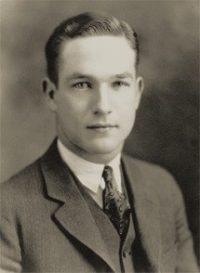
One aspect that brought the war closer to home was that Counter-Spy stories took place in, or close to the United States rather than abroad, with the first few years before the war ended devoted to tales with Lord’s fictional counter-spy, David Harding, and his assistant counter-spy Harry Peters (played by Mandel Kramer) dealing with Germany’s Gestapo and Japan’s Black Dragon spy agencies working clandestinely within the United States. Harding was special in that he was pretty much his own boss, with free-reign over what and how he handled sensitive cases while working with various government departments when his cases happened to cross into their individual jurisdictions. Don MacLaughlin (1906-86, photo top right) was cast as David Harding, his title being loosely interpreted as the head of the United States Counterspies Unit; one might legitimately say he was the Chief Counterspy of this “imaginary” unit. Like Lord, MacLaughlin was no newcomer to radio, having proved himself with his versatility in a number of prior action and dramatic productions. In truth, MacLaughlin had performed in, according to one source, “some 300 roles” since his radio debut in 1935. MacLaughlin secured the permanent role of Harding after the third episode, beating out some 20 others for the top spot. The Lord and MacLaughlin team turned out to be a match made in heaven, for MacLaughlin kept the role for the next 12 years. After the show ended in 1957, MacLaughlin began a new stage in his acting career as, for 30 years, he played attorney Chris Hughes on the daytime soap opera As the World Turns, until his death in 1986. Much interesting background could be added to this necessarily brief introduction to this one of a kind patriotic war time program, but suffice to say it became so popular so quickly that within a year it was so well-received that it took no summer hiatus, and for some of its future programming would be nominated for a Peabody Award and receive “numerous citations from local and civic groups throughout the 1940s.” Aside from a brief period of time (January 1949-August 1950) when it aired twice a week with Pepsi-Cola as the sponsor, David Harding, Counter-Spy was a weekly broadcast throughout its run.
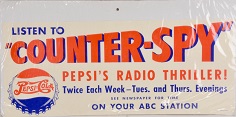
“The Case of the Desert Explosion” takes us to the high mountains of Mexico, where the hellish heat is destructive to most life forms, leaving many square miles of the country a desolate and foreboding wasteland, home only to the hardiest of human souls. And those local criminal enterprises wishing to protect their identities, nefarious activities, and illegal endeavors by remaining hidden from the prying eyes of government officials charged with protecting the lives of citizens from both Mexico and the United States. And also, in short, spies of extra-national origin. This episode features a new formulation, a radical new compound of Uranium as the MacGuffin, that potentially deadly radioactive substance that spies are willing to kill for if they can get their hands on it. And they will do anything to possess it, as it is being offered on the black market to the highest bidder. What adds to the grim seriousness of this playing-for-keeps scenario is the opening scene that sets the stage for what is to come, for a ruthless drug lord doubts the fidelity of one of his trusted gang underlings and murders her without blinking an eye. Our counter-spies eventually infiltrate the bad guys organization but the paranoia runs so deep in such a high stakes enterprise that even they are accused of being turncoats and working for the other side. Our counter-spies must walk a razor thin tightrope where the slightest or miscalculated misstep could spell their doom and allow the Uranium to fall into the wrong hands. In order to outsmart the bad guys, ingenuity and a little bit of luck are needed, so sit back and learn how David Harding, counter-spy earns his keep in “The Case of the Desert Explosion.”
(The linked CD above contains this week’s OTR episode. The CD is brand new, and radio historian and friend to this weekly feature, Karl Schadow has written the Program Guide from which a number of facts and figures in this introduction have been used, with thanks.)
Play Time: 29:15
{“The Case of the Desert Explosion” aired on a Thursday evening in May of 1949. With only a few weeks left in the school year, the neighborhood gang found it impossible to keep their minds on school. Their thoughts were focused on how quickly they could make it to the nearby newsstand after school that afternoon, and what sorts of adventures they would find there, which pulp magazines would they take home to tide them over for the upcoming weekend. Adventure (1910-71) was begun to hopefully cash in on the success of Argosy, which was at that point in time selling hundreds of thousands of copies per issue. Adventure‘s publisher took the basic premise but narrowed it to focus entirely on but two of the themes found in Argosy, those of danger and thrills. It proved wildly successful, as covers like the one below were emblematic of what its readers would discover in every issue, as pure adventure—with its attendant danger and thrills—had many faces and could be found in endlessly fascinating storylines and in exotic locales around the globe. Adventure was a monthly in 1949. fantastic Adventures (1939-53) began as a companion to Amazing Stories, but with (as one source has it) “lighter, frothier” fare, though it would, by the 1940s, be offering stories not that much different than its senior counterpart, though with a bit more “fantastic” element to its adventures. Through late 1947 until its final three issues early in 1953 fantastic Adventures was a monthly. G-Men Detective (1935-53) quickly became a favorite among the other pulps featuring government agent crime stories. Originally titled simply G-Men, when interest began to fade in such stories it was retitled to G-Men Detective in mid-1940 and switched to a bi-monthly from its former monthly schedule. 1949 saw the magazine transition once again, this time from its bi-monthly schedule to a quarterly with the issue below. It saw two bi-monthly and three quarterly issues in 1949.}
[Left: Adventure, 5/49 – Center: fantastic Adventures, 5/49 – Right: G-Men Detective, Spring/49]
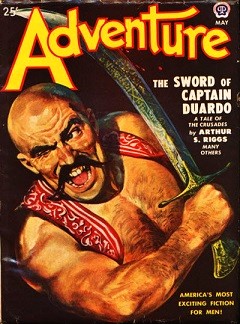
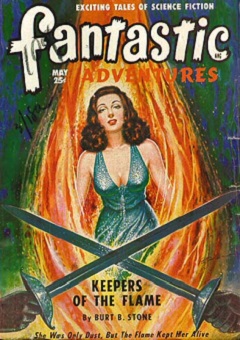
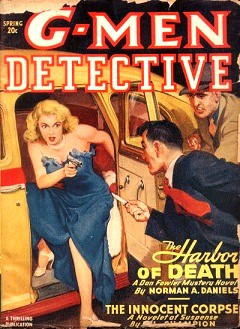
To view the entire list of weekly Old Time Radio episodes at Tangent Online, click here.